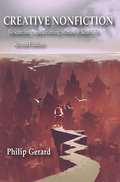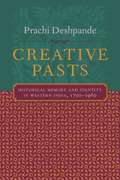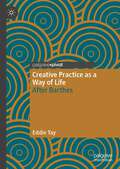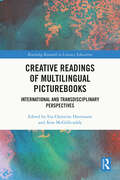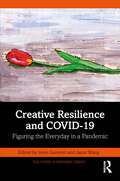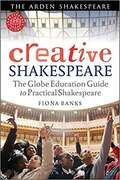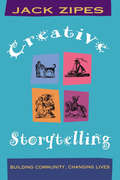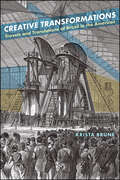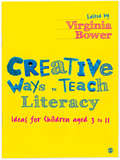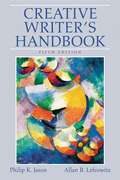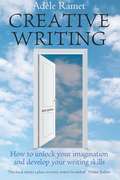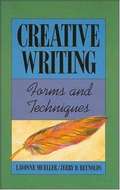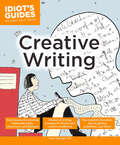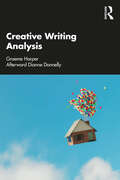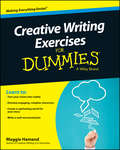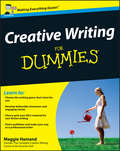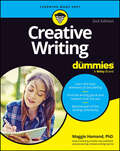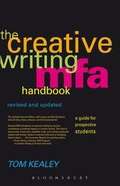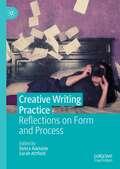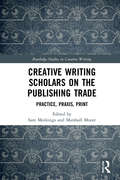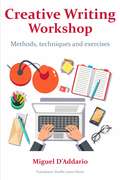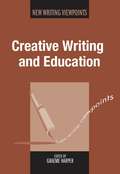- Table View
- List View
Creative Nonfiction: Researching And Crafting Stories Of Real Life
by Philip GerardWriting creative nonfiction intertwines journalistic truth and literary techniques to tell a story that is clear, accurate, and exploding with meaning. Philip Gerard artfully guides readers through the entire creative nonfiction writing process, going beyond the technical basics to address topics such as ethics, voice, and structural integrity. In response to the genre's evolution, the latest edition includes examples to illustrate how cultural changes have influenced the way writers conduct research, approach writing, and communicate during the production of their projects. Timely, engaging, and poetic, Creative Nonfiction is the practical manual every novice and seasoned writer will want on their bookshelf.
Creative Nonfiction: The Final Issue: The Best of Thirty Years of Creative Nonfiction
by Lee Gutkind and Leslie RubinkowskiThe very best writing from one of America’s most groundbreaking literary magazines. When Creative Nonfiction debuted in 1994, the literary genre it championed was largely the target of skepticism or downright ridicule. But at a time when few editors were interested in the personal essay, the magazine doggedly explored new ideas and fresh modes of expression, and over the next three decades, its contributors pioneered what would come to be known as the “fourth genre.” The thirty-two essays collected here bring together some of the finest work Creative Nonfiction published over its seventy-eight issues. Read Pulitzer Prize-winner Charles Simic’s boyhood remembrances of the bombing of Belgrade, Carolyn Forche’s haunting, lyric catalog of her daily life as she faced down a cancer diagnosis, and John Edgar Wideman’s meditation on the photo of a murdered boy his same age—Emmett Till—and how the image haunted him forever. Here, you'll find work by such luminaries as Adrienne Rich and John McPhee, but also essays from more contemporary voices like Brian Broome, Elizabeth Fortescue, and Anne McGrath. With an introduction by Lee Gutkind, Creative Nonfiction’s founder and editor, this collection captures the evolution of a genre and the amazing work of the little magazine that helped make it all happen.
Creative Pasts: Historical Memory and Identity in Western India, 1700-1960 (Cultures of History)
by Prachi DeshpandeThe "Maratha period" of the seventeenth and eighteenth centuries, when an independent Maratha state successfully resisted the Mughals, is a defining era in the history of the region of Maharashtra in western India. In this book, Prachi Deshpande considers the importance of this period for a variety of political projects including anticolonial/Hindu nationalism and the non-Brahman movement, as well as popular debates throughout the nineteenth and twentieth centuries concerning the meaning of tradition, culture, and the experience of colonialism and modernity. Sampling from a rich body of literary and cultural sources, Deshpande highlights shifts in history writing in early modern and modern India and the deep connections between historical and literary narratives. She traces the reproduction of the Maratha period in various genres and public arenas, its incorporation into regional political symbolism, and its centrality to the making of a modern Marathi regional consciousness. She also shows how historical memory provided a space for Indians to negotiate among their national, religious, and regional identities, pointing to history's deeper potential in shaping politics within thoroughly diverse societies.A truly unique study, Creative Pasts examines the practices of historiography and popular memory within a particular colonial context, and illuminates the impact of colonialism on colonized societies and cultures. Furthermore, it shows how modern history and historical memory are jointly created through the interplay of cultural activities, power structures, and political rhetoric.
Creative Power: The Nature And Nurture Of Children's Writing
by Ronald L. CramerThis accessible book examines the nature of children's writing, and helps teachers discover how to best nurture in children's creative potential. A thorough explanation of the practices and strategies needed to understand young writers and their writing, the book provides a wealth of information and ideas about the language, interests, and creative capabilities of today's children. Strong pedagogy offers explicit, practical examples with direct application to instruction. Each chapter begins with a brief vignette that captures the drama and excitement of becoming a writer. Boxed features summarize the best approaches to putting instructional concepts and strategies into practice. For Elementary English Teachers.
Creative Practice as a Way of Life: After Barthes (Palgrave Studies in Creativity and Culture)
by Eddie TayThis book combines autoethnographic reflections, poetry, and photography with the aim to bridge the gap between creative practice and scholarly research. Drawing on an innovative combination of different forms of knowledge, creative writing and street photographs are presented as means to reflect on the development of knowledge and self-knowledge through a thought-provoking dialogue with Roland Barthes’ post-structuralist work. What does it mean to be a creative practitioner in a world traversed by values of capitalism and artificial intelligence? What does it mean to teach creative practices in such an environment?The urban landscape of Singapore, with the Jewel Changi mall, the Universal Studios, and Little India in the background, is the stage where the capitalist demands of modern city life grapple with the solitary act of writing poetry and taking photographs through the personal experience of the author. Capitalist realism and depression realism entwine with Barthes' notion of vita nova in a mesmerizing phantasmagoria that drags the reader to the bowels and secret pleasures of the creative process.
Creative Readings of Multilingual Picturebooks: International and Transdisciplinary Perspectives (Routledge Research in Literacy Education)
by Áine McGillicuddy Esa Christine HartmannThis edited volume offers fresh perspectives on linguistic and cultural diversity in multilingual picturebooks, examining their potential to support multilingual learning in different educational contexts. Drawing on international, transdisciplinary perspectives from over fifteen countries, the book provides a comprehensive view of this unique literary genre.The collection showcases a wide range of languages featured in multilingual picturebooks, including Chinese, Farsi, Georgian, Irish, Korean, Malagasy, Mexican Indigenous languages, Mirandese, Northern Sámi, Portuguese, Spanish, Te Reo Māori, Ukrainian, and Welsh. Various chapters examine how multilingual picturebooks foster language and literacy development for emergent bilinguals in multilingual and multicultural environments, highlighting benefits such as linguistic and semiotic code-switching, as well as their ability to stimulate intercultural awareness in readers. The book also considers the creation, translation, and complex publishing processes of multilingual picturebooks, while exploring modern technologies such as eye tracking to analyse the reading processes of these books.Reflecting current insights and innovations in picturebook research, this volume will appeal to scholars, academics, and researchers in language and literacy education, multilingual education, and early childhood education. Those involved in children’s literature studies, multimodality, and bilingualism more broadly will also find this collection valuable.
Creative Resilience and COVID-19: Figuring the Everyday in a Pandemic (The COVID-19 Pandemic Series)
by Irene GammelCreative Resilience and COVID-19 examines arts, culture, and everyday life as a way of navigating through and past COVID-19. Drawing together the voices of international experts and emerging scholars, this volume explores themes of creativity and resilience in relation to the crisis, trauma, cultural alterity, and social change wrought by the pandemic. The cultural, social, and political concerns that have arisen due to COVID-19 are inextricably intertwined with the ways the pandemic has been discussed, represented, and visualized in global media. The essays included in this volume are concerned with how artists, writers, and advocates uncover the hope, plasticity, and empowerment evident in periods of worldwide loss and struggle—factors which are critical to both overcoming the COVID-19 pandemic and fashioning the post-COVID-19 era. Elaborating on concepts of the everyday and the outbreak narrative, Creative Resilience and COVID-19 explores diverse themes including coping with the crisis through digital distractions, diary writing, and sounds; the unequal vulnerabilities of gender, ethnicity, and age; the role of visuality and creativity including comics and community theatre; and the hopeful vision for the future through urban placemaking, nighttime sociability, and cinema. The book fills an important scholarly gap, providing foundational knowledge from the frontlines of the COVID-19 pandemic through a consideration of the arts, humanities, and social sciences. In doing so, Creative Resilience and COVID-19 expands non-medical COVID-19 studies at the intersection of media and communication studies, cultural criticism, and the pandemic.
Creative Shakespeare: The Globe Education Guide to Practical Shakespeare
by Fiona BanksThis unique book desribes the ways in which educational practitioners at Shakespeare's Globe theatre bring Shakespeare to life for students of all ages.The Globe approach is always active and inclusive - each student finds their own way into Shakespeare - focusing on speaking, moving and performing rather than reading. <p><p>Drawing on her rich and varied experience as a teacher, Fiona Banks offers a range of examples and practical ideas teachers can take and adapt for their own lessons. The result is a stimulating and inspiring book for teachers of drama and English keen to enliven and enrich their students' experience of Shakespeare.
Creative Storytelling: Building Community/Changing Lives
by Jack ZipesJack Zipes has reinvigorated storytelling as a successful and engaging tool for teachers and professional storytellers. Encouraging storytellers, librarians, and schoolteachers to be active in this magical process, Zipes proposes an interactive storytelling that creates and strengthens a sense of community for students, teachers and parents while extolling storytelling as animation, subversion, and self-discovery.
Creative Transformations: Travels and Translations of Brazil in the Americas (SUNY series in Latin American and Iberian Thought and Culture)
by Krista BruneIn Creative Transformations, Krista Brune brings together Brazilian fiction, film, journalism, essays, and correspondence from the late nineteenth to the early twenty-first centuries. Drawing attention to the travels of Brazilian artists and intellectuals to the United States and other parts of the Americas, Brune argues that experiences of displacement have had a significant influence on their work. Across Brazilian literary and cultural history, translation becomes a way of navigating and representing the resulting encounters between languages, interactions with Spanish Americans, and negotiations of complex identities. While Creative Transformations engages extensively with theories of translation from different national and disciplinary contexts, it also constructs a vision of translation uniquely attuned to the place of Brazil in the Americas. Brune reveals the hemispheric underpinnings of works by renowned Brazilian writers such as Machado de Assis, Sousândrade, Mário de Andrade, Silviano Santiago, and Adriana Lisboa. In the process, she rethinks the dynamics between cosmopolitan and national desires and between center and periphery in global literary markets.
Creative Ways to Teach Literacy: Ideas for Children aged 3 to 11
by Virginia BowerShortlisted for the UKLA Academic Book Award 2013! Covering the essential areas of practice, this book suggests ways to make your literacy teaching as creative and engaging as possible. Children get the most out of their learning when it is exciting, and this book offers great ideas for classroom practice, whilst making careful links to research. Sections advise on teaching narrative, poetry and non-fiction, and each chapter contains case studies and ideas to try out in practice. The authors cover a broad range of topics, including: - exploring traditional tales - writing from experience - using playground games as a foundation for literacy - performing poetry. Written for teachers working with children aged 3-11 years, this book gives you the opportunity to develop children's literacy in enjoyable and interesting ways.
Creative Writer's Handbook (5th Edition)
by Philip K. Jason Allan B. LefcowitzThis handbook is the perfect reference for beginning creative writers. It offers abundant illustrations, exercises, and useful techniques in all genres. While emphasizing problem-solving and the mastery of literary conventions, this handbook also takes the apprentice writer on a journey from inspiration to revision.
Creative Writing
by Adèle RametThis book is a first-rate guide for writers who are looking for ways to improve their output. It focuses on: - Fiction writing and the world of genre fiction - science, romance, horror and crime. - Ways of drawing on personal experience in order to write non-fiction articles on a wide variety of topics in a number of different styles. - Writing for children which requires specialist skills that, once mastered, bring enormous satisfaction to both the writer and the reader. - The impact of the internet on the creative writer and the opportunities it presents. Crucially, there is also a chapter on presenting your work to a publisher and getting it into print.
Creative Writing
by Adèle RametThis book is a first-rate guide for writers who are looking for ways to improve their output. It focuses on: - Fiction writing and the world of genre fiction - science, romance, horror and crime. - Ways of drawing on personal experience in order to write non-fiction articles on a wide variety of topics in a number of different styles. - Writing for children which requires specialist skills that, once mastered, bring enormous satisfaction to both the writer and the reader. - The impact of the internet on the creative writer and the opportunities it presents. Crucially, there is also a chapter on presenting your work to a publisher and getting it into print.
Creative Writing
by Lavonne Mueller Jerry D. Reynolds'Creative Writing' takes writers through all the steps--from keeping a writer's journal to submitting manuscripts for publication. In an exciting format featuring numerous examples from student and professional writing, 'Creative Writing' presents techniques and tips for writing poetry, fiction, drama, and journalism.
Creative Writing (Idiot's Guides)
by Casey ClaboughCreative writing is arguably the ultimate form of self-expression. Ideal for anyone interested in writing (student or not), Idiot's Guides: Creative Writing helps readers master the basics of crafting compelling fiction and nonfiction stories. Various genres, including novels, short stories, plays and screenplays, poetry, book-length and article-length narrative nonfiction, memoirs, and more are covered. Content includes the fundamental elements, such as plot, character, point-of-view, setting, dialogue, style, and theme. And readers will be able to hone their writing skills and boost their creativity with writing prompts and exercises.
Creative Writing Analysis
by Graeme HarperCreative Writing Analysis is a guide to solving creative writing problems; acting as a practical introduction to progressing a creative writing project as well as an exploration of the many ways in which creative writing can be understood. Through chapters on topics including writing methods, textual analysis, practice-led research, interdisciplinarity, and cultural contexts, this book explores the various forms of analysis that can be employed. Graeme Harper provides information to assist in creative decision making, and as a means for discussing approaches and outcomes in creative writing. The book also includes an Afterword by Dianne Donnelly, whose work in Creative Writing Studies has been widely recognized as a contribution to the critical examination of creative writing. Whether you are a creative writer seeking to improve your work or you are simply interested in analysing the practice and outcomes of others doing creative writing, Creative Writing Analysis offers strategies to assist students and practitioners of creative writing and literary studies.
Creative Writing Exercises For Dummies
by Maggie HamandTurn your inspiration into a story with clear, expert guidance Creative Writing Exercises For Dummies is a step-by-step creative writing course designed to hone your craft, regardless of ability. Written by the founder of the Complete Creative Writing Course at London's Groucho Club, this activity-based guide walks you through the process of developing and writing in a wide range of genres including novels, short stories and creative nonfiction. The book includes writing prompts, exercises, mind maps, flow charts and diagrams designed to get your ideas flowing. You'll get expert guidance into character development, plot structure and prose, plus extensive insight into self-editing and polishing your work. Whether you're a new writer with a seed of an idea you would like to develop, or are looking to strengthen your creative writing skills, this book has you covered. Covering every aspect of narrative, from setting initial goals to formatting a manuscript, Creative Writing Exercises For Dummies provides the tools and instruction you need to make your story the best it can be. Learn to spark your imagination and sketch out ideas Create compelling characters and paint a picture with description Develop your plot and structure and maintain continuity Step back from your work and become your own ruthless editor The rise of e-books has opened up the publishing world, even to non-established writers. If you have a story you're dying to tell but aren't sure how, Creative Writing Exercises For Dummies is the clear, concise solution you need.
Creative Writing For Dummies
by Maggie HamandDo you have an idea that you’re burning to get down on paper? Do you want to document your travels to far-flung places, or write a few stanzas of poetry? Whether you dream of being a novelist, a travel writer, a poet, a playwright or a columnist, Creative Writing For Dummies shows you how to unlock your creativity and choose the genre of writing that suits you best. Walking you through characterisation, setting, dialogue and plot, as well as giving expert insights into both fiction and non-fiction, it’s the ideal launching pad to the world of creative writing. Creative Writing For Dummies covers: Part I: Getting started Chapter 1: Can Everyone Write? Chapter 2: Getting into the Write Mind Chapter 3: Finding the Material to work with Part II: The Elements of Creative Writing Chapter 4: Creating Characters Chapter 5: Discovering Dialogue Chapter 6: Who is telling the story? Chapter 7: Creating your own world Chapter 8: Plotting your way Chapter 9: Creating a Structure Chapter 10: Rewriting and editing Part III: Different Kinds of Fiction Writing Chapter 11: Short stories Chapter 12: Novels Chapter 13: Writing for children Chapter 14: Plays Chapter 15: Screenplays Chapter 16: Poetry Part IV: Different kinds of Non-fiction writing Chapter 17: Breaking into journalism - Writing articles/ magazine writing Chapter 18: Writing from life and autobiography Chapter 19: Embroidering the facts: Narrative non-fiction Chapter 20: Exploring the world from your armchair - Travel writing Chapter 21: Blogging – the new big thing Part V: Finding an audience Chapter 22: Finding editors/ publishers/ agents Chapter 23: Becoming a professional Part VI: Part of Tens Chapter 24: Ten top tips for writers Chapter 25: Ten ways to get noticed
Creative Writing For Dummies
by Maggie HamandUnlock your creative potential and write something special Ever dream of writing a book, article, poem, or play that means something to you—and maybe to someone else as well? Do you have an idea you're ready to get down on paper? In Creative Writing For Dummies, you'll learn how to unleash your creative side and become a confident and productive writer. Discover the essential elements of storytelling, including structure, characterization, setting, dialogue, and plot, as you navigate the countless ways you can express yourself with the written word. Explore the media and methods you can use to help find an audience—from traditional to self-publishing, social media, blogging, and more! Creative Writing For Dummies also shows you how to: Write in all sorts of different formats, including screenplays, scripts, creative nonfiction, poetry, short stories, novels, and beyond Navigate the world of social media and learn how it can contribute to getting your work read by more people in more places Understand the new, online nature of contemporary journalism and the proliferation of news and blogging sites A can't-miss roadmap to getting your first—or hundred-and-first—story, poem, or script committed to paper, Creative Writing For Dummies is an essential read for aspiring, amateur, and professional writers everywhere.
Creative Writing MFA Handbook: A Guide for Prospective Graduate Students (2nd Edition)
by Tom KealeyRevised and Updated! The Creative Writing MFA Handbook guides prospective graduate students through the difficult process of researching, applying to, and choosing graduate schools in creative writing. The handbook includes profiles of fifty creative writing programs, guidance through the application process, advice from current professors and students including George Saunders, Aimee Bender, Tracy K. Smith, and Geoffrey Wolff, and the most comprehensive listings of graduate writing programs in and outside the United States. The handbook also includes special sections about Low-Residency writing programs, Ph. D. programs, publishing in literary journals, and workshop and teaching advice. In a remarkably concise, user-friendly fashion,The Creative Writing MFA Handbook answers as many questions as possible, and is packed with information, advice, and experience. This second edition updates and builds upon the first edition, which was published in 2005 to great acclaim and contains a vastly expanded ranking of current creative writing programs.
Creative Writing Practice: Reflections on Form and Process
by Debra Adelaide Sarah AttfieldCreative Writing Practice: reflections on form and process explores the craft of creative writing by illuminating the practices of writers and writer-educators. Demonstrating solutions to problems in different forms and genres, the contributors draw on their professional and personal experiences to examine specific and practical challenges that writers must confront and solve in order to write. This book discusses a range of approaches to writing, such as the early working out of projects, the idea of experimentation, of narrative time, and of failure. With its strong focus on process, Creative Writing Practice is a valuable guide for students, scholars and practitioners of creative writing.
Creative Writing Scholars on the Publishing Trade: Practice, Praxis, Print (Routledge Studies in Creative Writing)
by Sam MeekingsIn Creative Writing Scholars on the Publishing Trade: Practice, Praxis, Print, Sam Meekings and Marshall Moore, along with prominent scholar-practitioners, undertake a critical examination of the intersection of creative writing scholarship and the publishing industry. Recent years have seen dramatic shifts within the publishing industry as well as rapid evolution and development in academic creative writing programs. This book addresses all of these core areas and transformations, such as the pros and cons of self-publishing versus traditional publishing, issues of diversity and representation within the publishing industry, digital transformations, and possible career pathways for writing students. It is crucial for creative writing pedagogy to deal with the issues raised by the sudden changes within the industry and this book will be of interest to creative writing students and practitioners as well as publishing students and professionals.
Creative Writing Workshop
by Miguel D'AddarioThe dream of writing a book for prosperity is one of the so-called purposes in life. They all write it down together with “plant a tree” and “have a child” and most will marry, breed offspring and participate in a reforestation campaign but… what about the book? We walk through a bookstore or visit an exhibition of books from around the world and we are surprised that someone is able to write stories, collect biographies of illustrious men… And even in movies, “diaries” seem to be the ideal of any young person captured on screen. Could it be that it is impossible to write this book in order to leave a mark of our passage in this world? Let me tell you yes. Yes it is possible.
Creative Writing and Education
by Graeme HarperThis book explores creative writing and its various relationships to education through a number of short, evocative chapters written by key players in the field. At times controversial, the book presents issues, ideas and pedagogic practices related to creative writing in and around education, with a focus on higher education. The volume aims to give the reader a sense of contemporary thinking and to provide some alternative points of view, offering examples of how those involved feel about the relationship between creative writing and education. Many of the contributors play notable roles in national and international organizations concerned with creative writing and education. The book also includes a Foreword by Philip Gross, who won the 2009 TS Eliot Prize for poetry.
